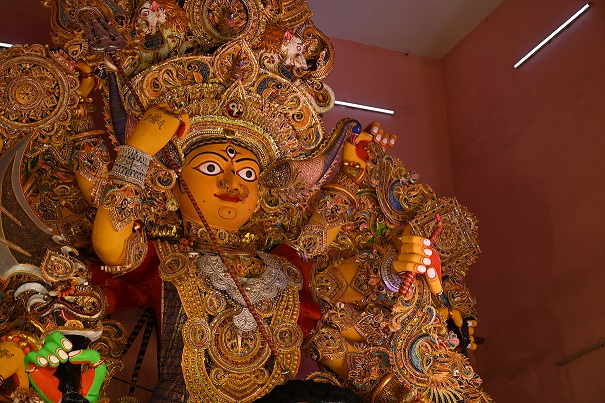It is popularly believed that this is the time of year when Goddess Durga travels from her bridal abode in Mount Kailash to her parental home on Earth. She is accompanied by her children, Ganesha, Kartikeya, Lakshmi, and Saraswati. She is venerated in her demon-slaying position flanked by her children. This is the image that is seen around the country during Durga Puja.
However, Puri, the abode of Lord Jagannath, celebrates Dussehra in a unique manner which is deeply rooted in tradition.
Here the goddess is worshipped alone and Durga is known as Gosani. Her event is appropriately named Gosani Jatra. This Dussehra, Sunday POST takes a close look at the myriad hues of Durga Puja in Holy City Puri.
Origin
Gosani Jatra is one of Puri’s oldest traditions of Durga Puja celebration. According to experts, ‘Gosani’ is considered to be derived from ‘Gosamani’, a name used for a woman with respect along the lines of ‘Jemamani’. The term can also be found in ancient Odia literature, ranging from the Madala Panji to Adikabi Sarala Dasa’s Mahabharata from the 15th century.
Distinct features
One of the distinguishing qualities of goddess Gosani is the intricate sola-jari work of Puri, a craft practically lost in other regions of Odisha. Furthermore, the goddess makes direct eye contact with the demon Mahisasura rather than the devotees. The weapon arrangement and pose are evocative of stone statues of Durga from Bhaumakara period temples. The asura is represented as a buffalo-headed human in the earliest stone sculptures discovered in Odisha, as seen at Gosani Jatra. Their faces are spherical, as in the traditional Odia art form of Pattachitra.
Celebration of woman dignity
The majority of Gosani images depict Durga defeating Mahisasura, however others do not, such as the Kantakadhi Gosani. According to a legend, goddess Durga takes a walk in the forest with her pet peacock, but the bird flees. She is chasing her peacock through the woods when a thorn pierces her foot. Vishnu, her brother, appears promptly and kneels down, carefully resting her foot on his knee and plucking the thorn out.
A few centuries ago, the thought of a man holding a woman’s foot would have been considered submissive and degrading; however, the picture of Kantakadhi traditionally communicates a message against such thinking and that treating a woman with respect does not make you any less of a man.
Dussehra and Naga worship
During the Durga Puja celebration, stunning Naga images are made and worshipped alongside the Gosanis. These male images represent the Shaiva religion, which practises Siva worship and wrestling, and they represent heroism and valour. They played an important part in repelling Muslim invasions in mediaeval Puri and symbolise the region’s Jaga-Akhada culture.
Experts speak
Noted historian Surendra Mishra says “The Gosani yatra is a time-honoured tradition in Puri, having survived for many generations within the city’s outskirts. According to mythology, it was founded by Choda Ganga Deva, the first Ganga king, who began the practice of Shakti Puja or Ishana Puja, guided by the tantric guru Nitei Dhobini’s teachings,” he said.
“Initially, individuals began their devotions to various gourd representations as goddesses in a symbolic act of reverence, mimicking tantric ceremonies These divine beings took on human characteristics over time, each assuming distinct poses, and their names were assigned based on their connections to specific gourd plants,” Mishra explained about goddesses being called after vegetables.
Sharing his insights on Naga worship, he quips, “It was established with the purpose of safeguarding Hindu monasteries, temples, and their supporters. These Nagas were the initial defenders of Buddhism in India, protecting it from various threats, including attacks from Muslims and Mughals. Consequently, shrines were constructed at prominent locations, designating them as Naga Sadhu sanctuaries.”
While the exact origins of Naga worship at these shrines remain uncertain, it is believed to have started after 1647 AD.
“A significant moment in its history occurred when Amir Nawab Fateh Khan launched an attack on the Balisahi shrine in Puri and killed Narsingh Dev. Naga Sadhus valiantly resisted this assault, preventing Fateh Khan from entering the temple through the Singhadwara gate. He eventually gained access through the southern entrance, plundering the temple’s treasures, but the Nagas pursued and killed the intruders on the Badadanda,” shared the culture scholar
Naga Puja has a connection with Punjab, according to another legend.
Jitendra Muduli, the founder of Hinjala Yaga Akhada of Puri, says, “The Naga tradition in Puri has its origins in Punjab, where Basant Rai, a disciple of Guru Gobind Singh, came to Puri during the Golden Temple attacks. During his visit, he crossed paths with a man named Deula Charan, who introduced him to Akhada for the purpose of learning kushti (wrestling) and self-defense. Inspired by the warriors in Punjab who attached 16 weapons to their bodies during battles, they decided to create a Naga figure with 16 arms, mirroring the concept of the 16 weapons of a veer. Among the 16 types of weapons carried by the Naga are guns, shields, knives, and gunpowder pouches. It’s noteworthy that Nagas, as brahmacharis, abstain from consuming cooked food and instead prefer cold items such as fruits and sweets.”
Manoj Mohanty, cashier of Balgundi Majana Jega, says, “The veneration of the Naga along with the goddess Gosani has been a cherished tradition that we continue to honour. Each year, the Naga idol has grown in size, and this year it stands at an impressive height of 25 feet. The Naga worship ritual spans four days, commencing with Saptami and culminating with Dasami, after which the idols are ritually immersed in a pond.”
He ends, “Besides Gosanis and Nagas other clay figures such as the bird Sampati with monkeys, Panchamukhi Hanuman, Ravana lifting Kailasa mountain, ghosts, figures of old man and woman are also made during the Durga Puja festival every year which reflects strong folk culture in its full glory.”
By Madhusmita Sahu, OP
